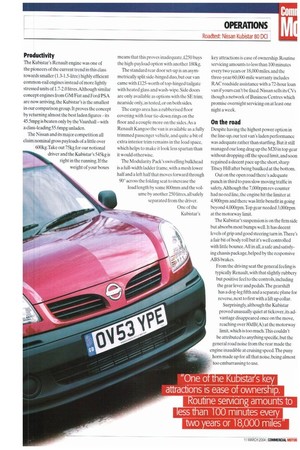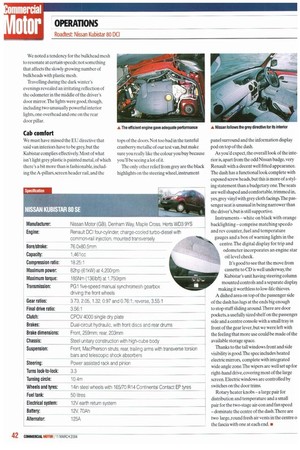SEND IN THE CLONES
Page 40

Page 41

Page 42

If you've noticed an error in this article please click here to report it so we can fix it.
Circumstances have conspired to stop us getting our hands on the face-lifted Renault Kangoo that debuted at last year's NEC CV Show. B ut what we have now driven is its twin brother, the Kubistar.This is the latest addition to Nissan's family of cloned Renault products.
The thinking behind the Renault organisation's second light CV brand is simple: add another network of outlets for basically the same producLattract a slightly different customer base, and hope it doesn't take too many of its sales from the existing clientele.
In fairness, thanks largely to Nissan's UK manufacturing operation, it has a modestly successfully share of the fleet car market; by offering a selection of competent commercials it can appeal to mixed-fleet operators attracted to a single-badge policy.
With a little help from Renault, Nissan's range is surprisingly comprehensive— from the Kubistar high-cube van here, via the inherited Primastar and Interstar panel vans to the powerful (if unimaginatively named) Pickup and the ageing Cabstar chassis-cab. All that's needed to complete the full range of light commercials is a 7,5-tonner: the Athleon range has yet to make it across the English Channel.
The Kubistar comes with a variety of power ratings, starting with a 60hp 1.2 petrol. But most operators, we suspect. will opt for the 1.5-litre common-rail turbo-diesel, rated at 57,65 and 82hp,They all drive the front wheels via a five-speed box. There are two trim levels. E and SE, the latter being the only choice with the most powerful engine as tested here.
We should point out that our test van was a late pre-production model, differing in some details from the final spec. For £10,447 for your 80 SE you get power steering,ABS and Brake Assist, remote central locking, radio/CD and an overhead storage shelf.The shelf didn't make it into our van but it did arrive with the Climate Pack of options (air-con, heat reflecting windscreen and pollen filter) and the Modularity Pack (roof hatch, swivelling tubular bulkhead and folding seat). Other options packs include Safety (with extra airbags), Glazing and Style, The Kubistar's Renault engine was one of the pioneers of the current trend in this class towards smaller (1.3-1.5-litre) highly efficient common-rail engines instead of more lightly stressed units of 1.7-2.0 litres. Although similar concept engines from GM/Fiat and Ford/PSA are now arriving, the Kubistar's is the smallest in our comparison group. It proves the concept by returning almost the best laden figures — its 45.5mpg is beaten only by the Vauxhall — with a class-leading 55.6mpg unladen.
The Nissan and its major competition all claim nominal gross payloads of a little over 600kg.Take out 75kg for our notional driver and the Kubistar's 545kg is right in the running. If the weight of your boxes means that this proves inadequate.£250 buys the high-payload option with another 180kg.
The standard rear door set-up is an asymmetrically split side-hinged duo, but our van came with £125-worth of top-hinged tailgate with heated glass and wash-wipe. Side doors are only available as options with the SE trim; nearside only, as tested, or on both sides.
The cargo area has a rubberised floor covering with four tie-down rings on the floor and a couple more on the sides. As a Renault Kangoo the van is available as a fully trimmed passenger vehicle, and quite a bit of extra interior trim remains in the load space, which helps to make it look less spartan than it would otherwise.
The Modularity Pack's swivelling bulkhead is a full-width ladder frame, with a mesh lower half and a left half that moves forward through 900 across the folding seat to increase the load length by some 800nm and the vol ume by another 250 litres, all safely separated from the driver. key attractions is ease of ownership. Routine servicing amounts to less than 100 minutes every two years or 18.000 miles. and the three-year/60,000-mile warranty includes RAC roadside assistance with a 72-hour loan van if yours can't be fixed. Nissan sells its CVs though a network of Business Centres which promise overnight servicing on at least one night a week.
Despite having the highest power option in the line-up. our test van's laden performance was adequate rather than startling. But it still managed our long drag up the M20 in top gear without dropping off the speed limit, and soon regained a decent pace up the short, sharp Titsey Hill after being baulked at the bottom.
Out on the open road there's adequate punch in third to pass slow moving traffic in safety.Although the 7,000rpm rev counter had no red line, the engine hit the limiter at 4.900rpm and there was little benefit in going beyond 4.000rpm.Top gear needed 3.000rpm at the motorway limit.
The Kubistar's suspension is on the firm side but absorbs most bumps well. It has decent levels of grip and good steering turn in.There's a fair bit of body roll but it's well controlled with little bounce. All in all, a safe and satisfying chassis package. helped by the responsive ABS brakes.
From the driving seat the general feeling is typically Renault, with that slightly rubbery hut positive feel to the controls. including the gear lever and pedals.The gearshift has a dog-leg fifth and a separate plane for reverse, next to first with a lift up collar.
Surprisingly, although the Kubistar proved unusually quiet at tickover, its advantage disappeared once on the move, reaching over 80dB(A) at the motorway limit, which is too much. This couldn't be attributed to anything specific, but the general road noise from the rear made the engine inaudible at cruising speed.The puny horn made up for all that noise, being almost too embarrassing louse. We noted a tendency for the bulkhead mesh to resonate at certain speeds:not something that affects the slowly growing number of bulkheads with plastic mesh.
Travelling during the dark winter's evenings revealed an irritating reflection of the odometer in the middle of the driver's door mirror. The lights were good, though, including two unusually powerful interior hights,one overhead and one on the rear door pillar_
Cab comfort
We must have missed the EU directive that said van interiors have to be grey, but the Kubistar complies effectively. Most of what isn't light grey plastic is painted metal, of which there's a bit more than is fashionable, including the A-pillars, screen header rail, and the tops of the doors_ Not too bad in the tasteful cranberry metallic of our test van, but make sure you really like the colour you buy because you'll be seeing a lot of it.
The only other relief from grey are the black highlights on the steering wheel. instrument panel surround and the information display pod on top of the dash.
As you'd expect,the overall look of the interior is, apart from the odd Nissan badge, very Renault with a decent well fitted appearance. The dash has a functional look complete with exposed screw heads, but this is more of a styling statement than a budgetary one_The seats are well shaped and comfortable, trimmed in, yes, grey vinyl with grey cloth facings.The passenger seat is unusual in being narrower than the driver's, but is still supportive.
Instruments — white on black with orange backlighting — comprise matching speedo and rev counter, fuel and temperature gauges and a box of warning lights in the centre.The digital display for trip and odometer incorporates an engine star oil level check.
It's good to see that the move from cassette to CD is well underway, the Kubistar's unit having steering column mounted controls and a separate display making it worthless to low-life thieves.
A dished area on top of the passenger side of the dash has lugs at the ends big enough to stop stuff sliding around.There are door pockets,a usefully sized shelf on the passenget side and a centre console with a small tray in front of the gear lever, but we were left with the feeling that more use could be made of the available storage space.
Thanks to the tall windows front and side visibility is good. The spec includes heated electric mirrors, complete with integrated wide angle zone.The wipers are well set up for right-hand drive, covering most of the large screen. Electric windows are controlled by switches on the door trims.
Rotary heater knobs — a large pair for distribution and temperature and a small pair for the two-stage air-con and fan speed — dominate the centre of the dash.There are two large,round fresh air vents in the centre o the fascia with one at each end.
































































































































































































